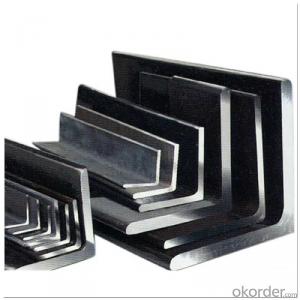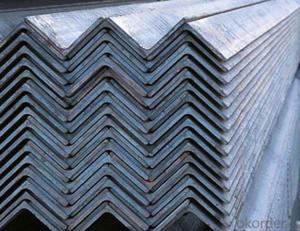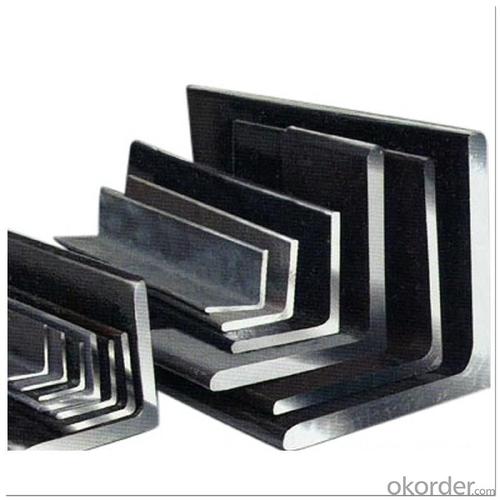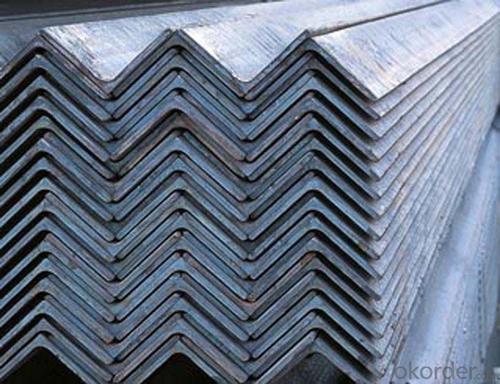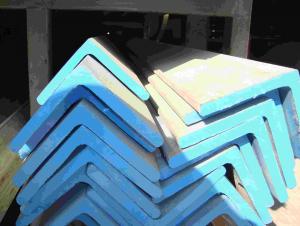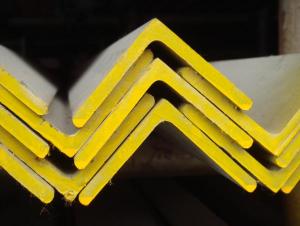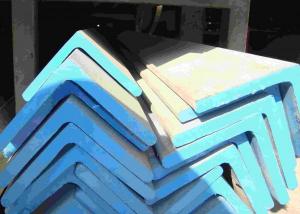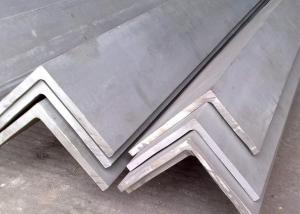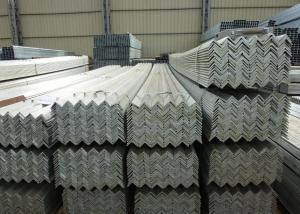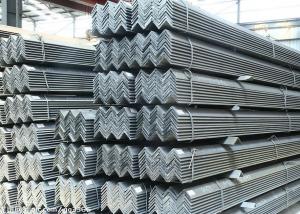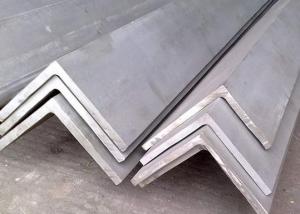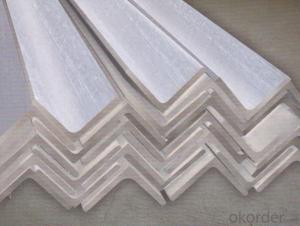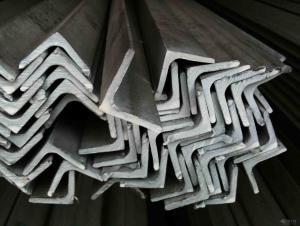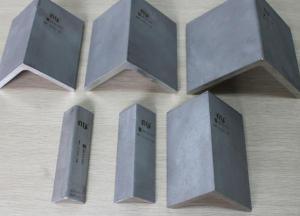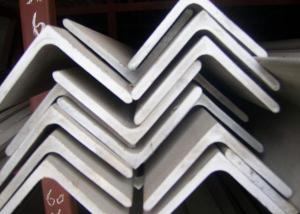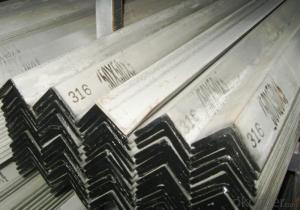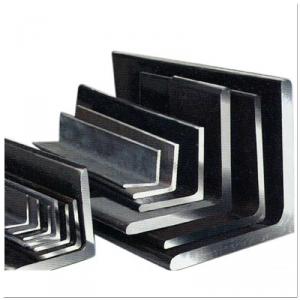stainless angles steel aisi 304 in L shaped
- Loading Port:
- Qingdao
- Payment Terms:
- TT OR LC
- Min Order Qty:
- 10 m.t.
- Supply Capability:
- 5000 m.t./month
OKorder Service Pledge
OKorder Financial Service
You Might Also Like
Products Information
Standard | AISI, ASTM, BS, DIN, GB, JIS, etc |
Grade | Q195, Q215, Q235, Q345, SS400, A36, S235JR, ST37, etc |
Technical parameters:
1) Material: Q235B , Q 345B, SS400 ,SS540, S235JR ,ETC. | |||
| 2) Usage: structure construction and electronic tower building | |||
| 3) Weight tolarance: -4% TO -10% | |||
| 4) Size tolarance : | |||
| ANGLE STEEL SIstructural steel angleE TOLARANCE (MM) | |||
| SIstructural steel angleE cm | WIDTH b/mm | THICKNESS d/mm | LENGTH /m |
| 2-5.6 | +/-0.8 | +/-0.4 | 4-12 |
| 6.3-9 | +/-1.2 | +/-0.6 | 4-12 |
| 10-14 | +/-1.8 | +/-0.7 | 4-12 |
| 16-20 | +/-2.5 | +/-1.0 | 4-12 |
| 5) Payment terms: TT or LC | |||
| 6) Delivery date: within 30 days after receiving the LC or TT prepay | |||
| 7) Packing: Export package | |||
| 8) Inspection: accept third party inspection | |||
Added information
| ||
Standard | ASTM A276, A484, A479, A580, A582, JIS G4303, JIS G4311, DIN 1654-5,DIN 17440,GB/T 1220 | |
Material | 200,300,400series, 201,202,301,304,304L,309S,310S,316,316L,316Ti,317,317L,321,347H,410,420,430,etc | |
Type | Round,square,hexagonal,flat,angle | |
Surface | Pickled,Black,Bright,Polishing,Blasting,etc | |
Specifications | Round bar | Diameter: 3mm~800mm |
Angle bar | Size: 3mm*20mm*20mm~12mm*100mm*100mm | |
Square bar | Size: 4mm*4mm~100mm*100mm | |
Flat bar | Thickness: 2mm~100mm | |
Width: 10mm~500mm | ||
Hexagonal | Size: 2mm~100mm | |
Length | 6m,5.8m,12m or as required | |
Price Term | FOB, CFR, CIF,CNF | |
Payment Term | T/T,L/C, | |
Minimum order quantity | 10 Ton | |
Package | Bundled,wooden box for export standard package. Export standard package, bundled or be required. The inner size of container is below: 20ft GP: 5.9m(length) x 2.13m(width) x 2.18m(high) about 24-26CBM 40ft GP: 11.8m(length) x 2.13m(width) x 2.18m(high) about 54CBM 40ft HG: 11.8m(length) x 2.13m(width) x 2.72m(high) about 68CBM | |
Delivery Time | Normally according to the order quantity | |
Application | Stainless steel bar applies to petroleum, chemical industry,electric power, boiler, high temperature resistant, low temperature resistant, corrosion resistant seamless steel pipe used. Stainless steel bar Stainless can be made according to the customers requirements. Fasten delivery. Quality assured. | |
- Q: How does stainless steel angle perform in corrosive gases or fumes?
- Stainless steel angle is renowned for its exceptional corrosion resistance properties, making it a highly suitable material for applications involving corrosive gases or fumes. The chromium content in stainless steel forms a protective layer on the surface, known as a passive film, which prevents the metal from reacting with the surrounding environment. This passive film acts as a barrier against corrosive agents, such as gases or fumes, effectively shielding the stainless steel from degradation or rusting. In the presence of corrosive gases or fumes, stainless steel angle maintains its integrity and remains resistant to corrosion. It does not undergo any chemical reactions or deterioration that can compromise its structural strength or aesthetics. This corrosion resistance is especially important in industries such as chemical processing, oil and gas, and wastewater treatment, where exposure to corrosive gases or fumes is common. Moreover, stainless steel angle also exhibits excellent resistance to pitting corrosion, crevice corrosion, and stress corrosion cracking, further enhancing its performance in corrosive environments. These characteristics make stainless steel angle a reliable and durable choice for applications where protection against corrosive gases or fumes is crucial. However, it is essential to choose the appropriate grade of stainless steel angle for specific corrosive environments. Different grades of stainless steel have varying levels of corrosion resistance, and certain environments may require higher alloyed stainless steels to ensure optimal performance. Consulting with a materials engineer or corrosion specialist can help in selecting the most suitable stainless steel grade for a particular application involving corrosive gases or fumes.
- Q: What are the common industries that use stainless steel angles?
- Stainless steel angles find application in a wide range of industries due to their versatile properties and durability. Some of the common industries that extensively use stainless steel angles include construction, architecture, manufacturing, and transportation. In the construction industry, stainless steel angles are widely used for structural purposes. They provide support and reinforcement in various building components such as beams, columns, and frames. Stainless steel angles are known for their high strength-to-weight ratio, corrosion resistance, and ability to withstand extreme weather conditions, making them an ideal choice for construction projects. Architects often utilize stainless steel angles in their designs for aesthetic purposes. These angles can be used for decorative trims, handrails, and balustrades, adding a modern and sleek look to buildings. Stainless steel angles offer a clean and polished appearance, making them popular in architectural applications. Manufacturing industries, particularly those involved in machinery and equipment production, also rely on stainless steel angles. These angles are commonly used in the fabrication of conveyor systems, platforms, and industrial equipment. The corrosion resistance and robustness of stainless steel angles make them suitable for harsh and demanding manufacturing environments. Transportation industries, including automotive, aerospace, and marine sectors, often incorporate stainless steel angles in their designs. In these industries, stainless steel angles are utilized for manufacturing vehicle frames, shipbuilding components, and aircraft structures. The high strength and corrosion resistance of stainless steel angles make them reliable and long-lasting solutions in the transportation sector. Overall, stainless steel angles are widely employed in construction, architecture, manufacturing, and transportation industries due to their exceptional properties. Their versatility, strength, and resistance to corrosion make them an ideal choice for various applications across different sectors.
- Q: What are the different shapes available in stainless steel angles?
- Stainless steel angles are available in various shapes including equal angles, unequal angles, L-shaped angles, and rounded angles.
- Q: Are stainless steel angles suitable for conveyor belts?
- Yes, stainless steel angles are suitable for conveyor belts. Stainless steel has excellent corrosion resistance and durability, making it an ideal material for conveyor belt applications. It can withstand high temperatures, heavy loads, and harsh environments, ensuring reliable and long-lasting performance.
- Q: What is the resistance to thermal expansion of stainless steel angles?
- The resistance to thermal expansion in stainless steel angles may vary depending on the specific grade of stainless steel being utilized. Generally speaking, stainless steel possesses a low coefficient of thermal expansion, resulting in minimal expansion and contraction when exposed to temperature fluctuations. This characteristic is a key factor in the widespread use of stainless steel in industries where the control of thermal expansion is crucial, such as construction, aerospace, and automotive sectors. Nevertheless, it is imperative to acknowledge that various grades of stainless steel can exhibit slightly different coefficients of thermal expansion. Therefore, it is advisable to refer to the specific technical data sheet of the stainless steel grade under consideration for precise information regarding its resistance to thermal expansion.
- Q: How do you determine the weight of a stainless steel angle?
- To determine the weight of a stainless steel angle, you would need to know the dimensions (length, width, and thickness) of the angle and then use the specific gravity or density of stainless steel to calculate its weight.
- Q: What are the electrical conductivity properties of stainless steel angles?
- Compared to other metals, stainless steel angles possess relatively low electrical conductivity properties. This is attributed to the presence of chromium in stainless steel, resulting in the formation of a passive oxide layer on the metal's surface. This oxide layer functions as an insulator, diminishing the flow of electrical current through the material. It should be noted, however, that stainless steel angles are still capable of conducting electricity to some degree, albeit less efficiently than metals such as copper or aluminum. The electrical conductivity of stainless steel angles can also be influenced by variables like alloy composition, surface finish, and temperature.
- Q: Are stainless steel angles expensive?
- Stainless steel angles can vary in price depending on factors such as the grade of stainless steel, the size of the angle, and market conditions. Generally, stainless steel angles tend to be more expensive compared to other materials due to their durability, corrosion resistance, and aesthetic appeal. However, the cost can be justified by the longevity and low maintenance required, making them a cost-effective choice in the long run.
- Q: How do you store stainless steel angles to prevent corrosion?
- Proper storage techniques are of utmost importance when it comes to preventing corrosion in stainless steel angles. The first step is to ensure that these angles are stored in a clean and dry environment. Moisture plays a significant role in the corrosion process, so it is crucial to keep the storage area completely free from any dampness or humidity. In addition, it is advisable to store stainless steel angles in a vertical position rather than horizontally. This positioning helps to prevent any potential accumulation of water or moisture on the surface, ultimately reducing the risk of corrosion. Moreover, storing the angles vertically also safeguards them against any potential damage caused by excessive weight or pressure. Furthermore, it is highly recommended to keep stainless steel angles at a safe distance from any corrosive materials. Certain chemicals, salts, and acids have the ability to corrode stainless steel, making it essential to avoid storing the angles in close proximity to these substances. Another effective method to prevent corrosion is to apply a protective coating on the stainless steel angles. This can be achieved by using a suitable corrosion-resistant paint or a specialized coating specifically designed for stainless steel. The coating acts as a protective barrier against moisture and other corrosive elements, thereby extending the lifespan of the angles. Regular inspection and maintenance are also key in preventing corrosion. It is important to regularly check the storage area for any signs of moisture or corrosive materials and address the issue promptly. Furthermore, it is essential to regularly clean the stainless steel angles using mild soap and water, ensuring they are thoroughly dried before returning them to storage. By following these guidelines, you can effectively store stainless steel angles and minimize the risk of corrosion, ultimately ensuring their longevity and preserving their quality.
- Q: Are stainless steel angles suitable for manufacturing process equipment?
- Manufacturing process equipment can benefit greatly from the use of stainless steel angles. The exceptional corrosion resistance, strength, and durability of stainless steel make it a perfect fit for the demanding conditions found in process equipment. The structural stability offered by stainless steel angles allows them to endure high temperatures and pressures without compromising their integrity. Additionally, stainless steel is renowned for its ease of cleaning and maintenance, making it an ideal choice for industries with strict hygiene standards like food processing, pharmaceuticals, and chemical manufacturing. Its resistance to chemical reactions also makes it well-suited for handling corrosive substances. Incorporating stainless steel angles into the construction of process equipment provides much-needed rigidity and support. They can be easily welded, machined, and fabricated to meet specific design requirements, ensuring that the equipment is properly sized and reinforced. In conclusion, stainless steel angles are an excellent option for manufacturing process equipment because of their corrosion resistance, strength, durability, and versatility in fabrication.
Send your message to us
stainless angles steel aisi 304 in L shaped
- Loading Port:
- Qingdao
- Payment Terms:
- TT OR LC
- Min Order Qty:
- 10 m.t.
- Supply Capability:
- 5000 m.t./month
OKorder Service Pledge
OKorder Financial Service
Similar products
Hot products
Hot Searches
Related keywords
